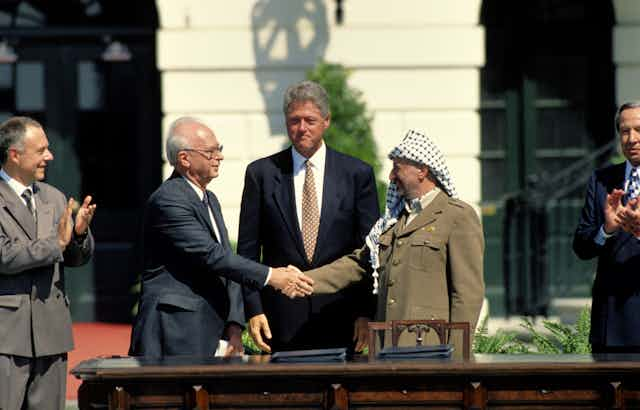The photo marking the moment is so enduring because it once seemed so unlikely. President Bill Clinton towered over two other men as he encouraged them to shake hands. Yitzhak Rabin, then Israeli prime minister, and Yasser Arafat, chairman of the Palestine Liberation Organization (PLO), were smaller in stature than Clinton. To their separate and warring peoples, though, they were giants who seemed then to be on the verge of creating an historic agreement.
That was September 13, 1993. That picture, taken on the White House lawn after secret negotiations in Oslo, is remembered now perhaps as a time of great hope, but also as the start of a process that ultimately did not succeed.
Today, there is no lasting peace between Israelis and Palestinians, there is no Palestinian state, and the Israeli occupation has expanded and deepened. Yet there is much to understand, to discuss and to learn from this moment in history.
Three decades later, we have made a three-part podcast series for The Conversation Weekly podcast to revisit what became known as the Oslo process.
One of us grew up in the region; the other travelled and worked there as a journalist during the second Palestinian intifada, or uprising, against Israeli occupation in the early 2000s. Now we both teach at City, University of London: one of us in international politics, the other in journalism. Our own personal experiences led us to make the region a focus of our academic research.
Part of our purpose in making this podcast series is to see what we can learn as researchers about relations between Israel and the Palestinians. We are also very keen to bring new insight through interviews with leading participants in the Oslo process.
Perhaps even more importantly, as educators now teaching students, many of whom don’t remember the era, we want to inform a new generation of what happened. It became clear to us, from our earliest conversations about the series, that the Israeli-Palestinian conflict was increasingly coming up in discussions on campus – and we wanted to satisfy that curiosity.
Inside the negotiations
The series examines the key issues shaping the Oslo peace process, as it became to be known. It starts by exploring the secret phase of negotiations, which began in meetings between Israeli academics and official representatives of the PLO. How and why would the protagonists of this drama find themselves in a remote Norwegian wood rather than in Washington or perhaps Madrid, where official negotiations between Israel and Arab states were taking place? We talk to Jan Egeland, one of the Norwegian negotiators, about what he remembers – and the reaction when the secret talks became public.
We then move to looking at the peace process itself, which was kicked off by the September 1993 ceremony at the White House where the Israel-PLO Declaration of Principles was signed. The pomp and flair of the occasion may have given the impression that Rabin and Arafat had just concluded a peace agreement, but in fact their long and arduous journey had just begun. What shaped subsequent events? What were the factors preventing the Oslo Peace from yielding the ultimate goal of Israeli-Palestinian peace?
With the help of two of leading figures, Palestinian politician Hanan Ashrawi and Israeli politician Yossi Beilin, we trace the highs and lows of the Oslo process. They tell us what they believe shaped subsequent events, and what were the factors that prevents the Oslo process from yielding the ultimate goal of Israeli-Palestinian peace. Throughout, we’re well aware of the megaphone war, which too often stifles open debate upon this most crucial of episodes in Middle East history.
Looking at the Oslo peace process with the benefit of 30 years of hindsight is not only important for understanding how it evolved. It is also an excellent opportunity to assess the legacy of this period of intense negotiations, at what appears to be a critical historical juncture: a time when the peace process is all but non-existent; when a new generation of Palestinians is demanding change; when Israel is tense with internal political confrontation.
Having grown up on the notion that the so-called two-state solution is the only way to resolve the Israeli-Palestinian conflict, we assess whether this formula is still viable. And if not, what lies ahead for Israel and the Palestinians as they begin writing the next chapter in their painful history.
To listen to the series, subscribe to The Conversation Weekly podcast.

